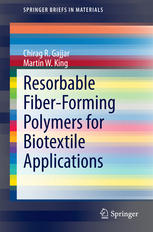

Most ebook files are in PDF format, so you can easily read them using various software such as Foxit Reader or directly on the Google Chrome browser.
Some ebook files are released by publishers in other formats such as .awz, .mobi, .epub, .fb2, etc. You may need to install specific software to read these formats on mobile/PC, such as Calibre.
Please read the tutorial at this link: https://ebookbell.com/faq
We offer FREE conversion to the popular formats you request; however, this may take some time. Therefore, right after payment, please email us, and we will try to provide the service as quickly as possible.
For some exceptional file formats or broken links (if any), please refrain from opening any disputes. Instead, email us first, and we will try to assist within a maximum of 6 hours.
EbookBell Team

4.7
16 reviewsThis book summarizes the properties and applications of conventional and commercially available fiber-forming, bioresorbable polymers, as well as those currently under study, for use as biotextiles. Factors affecting the performance of these biomaterials are presented, and precautionary measures to reduce premature, hydrolytic degradation during manufacturing and processing are discussed. Because of the structural requirements of medical devices and the technological advancements in synthetic fibers and textile technology, the new field of "Biotextiles" has evolved to exploit the potential of various woven, knitted, braided and non-woven textile structures for biomedical applications. Textile substrates provide certain unique mechanical properties to the medical device and because of an inherently high level of porosity, they can encourage cell growth and promote migration and proliferation. Bioresorbable devices that assist in the repair and regeneration of damaged tissues have in recent years replaced many of the permanent prosthetic devices. Thus, the topic of “Bioresorbable Biomaterials” generates much interest and research activity in the field of biomaterials science today. For this reason, the use of bioresorbable polymers as fibers is currently dominating the field of resorbable biomaterials for applications from sutures to tissue engineering scaffolds.